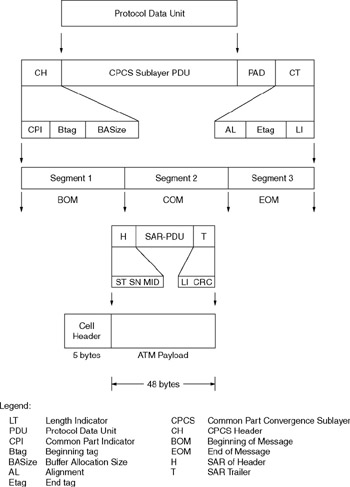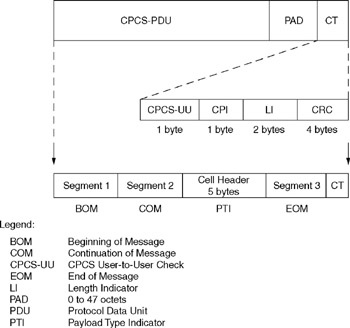Chapter 9: ATM Performance
This chapter examines ATM with respect to its performance. In doing so we build upon our base of knowledge concerning ATM previously presented in Chapter 2, our examination of the application of waiting line analysis presented in Chapter 4, and knowledge of Ethernet performance obtained in Chapter 7.
In Chapter 2 we discussed four ATM Adaption Layer (AAL) services as well as obtained a general overview of the basic 53-byte ATM cell. In this chapter we probe deeper into each AAL, examining the segmentation process that results in the format of the AAL cell and its effect on AAL cell data transport capability. Once this is accomplished, we turn our attention to LAN Emulation and develop a general model and exercise that model to examine the effect of LAN Emulation on ATM performance. In doing so we apply waiting line analysis to ATM to obtain an appreciation for and understanding of the effect of queuing on the LAN Emulation process.
9.1 AAL Cell Variations
In Chapter 2 we noted that there are four AALs: AAL-1, AAL-2, AAL-3/4, and AAL-5. Each AAL uses a predefined cell format when it segments data from high layers into ATM cells . In this section we examine the segmentation process and the resulting cell formats obtained from the use of different AALs as well as their potential effect on ATM performance.
9.1.1 AAL-1
AAL-1 is used to support a constant bit rate connection that has a timing relationship between source and destination. During the segmentation process, the convergence layer segments each protocol data unit (PDU) into 48-byte entities that contain a one-byte header with three fields. That header is placed within the payload area of each cell, reducing the payload to 47 bytes of user data.
Figure 9.1 illustrates the AAL-1 cell format. Note that the one-bit convergence sublayer indicator (CSI) is followed by a three-bit sequence number (SN) field and a four-bit sequence number protection (SNP) field. The SN is used to detect cell insertion and cell loss, while the SNP is used to correct errors that occur in the sequence number.

Figure 9.1: AAL-1 Cell Format
9.1.2 AAL-2
AAL-2 is used to transfer time-dependent variable bit rate data. To do so, AAL-2 transmits timing information with the data, enabling the timing dependency to be recovered at the cell destination. As data is segmented at the AAL-2 layer, a header and trailer are added to each cell's payload, resulting in 46 bytes being available in the payload to actually transport data. Figure 9.2 illustrates the AAL-2 cell format. The AAL-2 header contains two fields: a sequence number (SN) used to detect inserted or lost cells and an information type (IT) field. The latter has one of three values: Beginning of Message (BOM), Continuation of Message (COM), or End of Message (EOM). The trailer also contains two fields: a length indicator (LI) field that contains the number of data bytes in a partially filled cell and a cyclic redundancy check (CRC) field that is used by the SAR sublayer to correct errors.

Figure 9.2: AAL-2 Cell Format
9.1.3 AAL-3/4
AAL-3 was developed to support time-independent variable rate data while AAL-4 was developed to transport time-independent variable bit rate data in a connectionless mode. Due to similarities between the two, they were combined into a common AAL referred to as AAL-3/4.
Figure 9.3 illustrates the steps in the flow of data associated with AAL-3/4. First, data from the upper user layer is passed in the form of a service data unit (SDU) to the convergence sublayer of the AAL. At this point, AAL-3/4 subdivides the convergence sublayer into a service specific convergence sublayer (SSCS) and a common part convergence sublayer (CPCS). The upper layer SDU is passed through the SSCS unchanged. In comparison, the CPCS adds a four-byte header, a four-byte trailer, and up to three bytes of padding to ensure that the entire PDU is divisible by 4. The CPCS-PDU is then passed on to the segmentation and reassembly (SAR) sublayer of the AAL, where the entire PDU, to include the added header, trailer, and any pads, are segmented into 44-byte pieces. The SAR adds a two-byte header and a two-byte trailer to each segment, resulting in a 48-byte payload that contains 44 bytes of data.

Figure 9.3: AAL-3/4 Data Flow and Cell Formation
The CPCS header contains three fields. The first field is the common part indicator (CPI) field, which indicates that the payload is part of the common part. The second field is the begin tag (Btag) field, which marks the start of the protocol data unit, while the third field, the buffer allocation size (BAsize), informs the receiver of the amount of buffer space required to accommodate the message.
Similar to the header, the trailer also contains three fields. The first field is an alignment (AL) field. This field is a byte filler that is employed to make the header and trailer the same length at four bytes each. The second field in the trailer is an end tag (Etag), which is used to mark the end of the PDU. The third field is the length indicator (LI), which indicates the length of the PDU payload.
At the SAR sublayer, a header and trailer are added to each segment. The header contains information concerning the segment order, while the trailer includes a CRC field. The lower portion of Figure 9.3 illustrates the AAL-3/4 SAR-PDU format prior to an ATM cell being formed . Note that the header contains three fields: a two-bit segment type (ST) field that indicates one of four segment types, a four-bit sequence number (SN) field, and a ten-bit multiplexing identification (MID) field. The latter is used to multiplex two or more CPCS connections onto a single ATM layer connection. The SAR trailer contains two fields: a six bit length indicator (LI) field that indicates the number of bytes contained in the payload portion of the segment and a ten-bit CRC. Based on the preceding , not only is AAL-3/4 relatively complex, but, in addition, its 44-byte payload capacity adversely affects data transfer.
9.1.4 AAL-5
The complexity of AAL-3/4 as well as its relatively high overhead of four bytes for every 48 bytes of ATM user information resulted in the requirement for a simplified AAL. That requirement was met by AAL-5, which places headers and trailers onto the convergence sublayer PDU instead of the SAR-PDU. Other "tricks" employed by AAL-5 to reduce overhead include assuming data is sequenced by the user and the use of the payload type indication (PTI) bit in the cell header to indicate the last cell in a transmission sequence. These "tricks" eliminate the necessity to include the SN and LI fields in each cell; however, they are included in some cells as they are used in fields in the common part convergence sublayer (CPCS), which is passed to the SAR-PDU prior to segmentation into a series of cells.
Figure 9.4 illustrates the formation of an AAL-5 cell. Note that the CPCS-PDU trailer winds up placed in the cell transporting the end of message (EOM), which means that its eight-byte trailer only reduces the payload in the last cell in a sequence. Assuming an average of three cells per sequence, this results in 8/3, or an average payload reduction of 2.55 bytes. The actual payload reduction depends on the length of the cell sequence. Because the LI field is two bytes in length, this means the number of cells can be up to 65,535. Thus, when the cell sequence is 1, the payload reduction is 8 bytes/1, which results in a payload capacity of 40 bytes for a worst-case scenario. If the cell sequence is 65,535, then the payload reduction is 8 bytes/65,535, or 0.000122 bytes, resulting in a best-case payload capacity of 47.9998 bytes.

Figure 9.4: AAL-5 Cell Formation
9.1.5 Payload Capacity
To illustrate the effect of different AALs on ATM payload capacity, let us begin with the common ATM line operating rate of 155.520 Mbps. Every 27th ATM cell is used to convey operational, administrative, and maintenance (OAM) information and is not available to transport data. This means that 155.520/27 or 5.76 Mbps is used for OAM, resulting in a line operating rate of 149.76 Mbps available for ATM cells transporting data.
Each ATM cell has a five-byte header, reducing the payload area to 48 bytes. This means that for a best-case scenario, 149.76 Mbps * 48/53 or 135.63169 Mbps is available for the cell payload.
AAL-1 transports data using a one-byte header within the payload area. Thus, the payload capacity is reduced to 135.63169 * 47/48 or 132.80602 Mbps.
AAL-2 transports data using two bytes of overhead within the 48-byte payload, reducing the payload to 46 bytes. Thus, the payload capacity is reduced to 135.63169 Mbps * 46/48, or 129.98036 Mbps.
AAL-3/4 uses four bytes of overhead within the 48-byte ATM cell payload area, reducing the effective payload to 44 bytes. Thus, the effective payload capacity becomes:
AAL-5 places its overhead into the CPCS-PDU, which results in the eight- byte trailer being contained in the cell transporting the EOM. As previously discussed, the eight bytes of overhead are contained in the last cell in the cell sequence. Because the cell sequence can vary from 1 to 65,535 cells, the reduction in the payload can range from a best case of 0.000122 bytes to a worst case of 8 bytes. Thus, the actual payload per cell can range from 40 bytes to 47.998 bytes.
Using a payload of 40 bytes, the payload capacity for AAL-5 becomes 135.63169 Mbps * 40/48, or 113.0264 Mbps. Using a payload of 47.9998 bytes, the payload capacity becomes 135.63169 Mbps * 47.9998/48, or 135.63112 Mbps. If we assume an average overhead of 2.66 bytes per 48 bytes of payload, this reduces the effective payload to 45.33 bytes. Then, the actual payload capacity for an AAL-5 payload becomes 135.63169 Mbps * 45.33/48, or 128.09565 Mbps. Table 9.1 summarizes payload capacity by AAL and indicates that not every AAL is created equal with respect to its payload capacity.
| AAL | Payload Capacity (Mbps) |
|---|---|
| AAL-1 | 132.80602 |
| AAL-2 | 129.98036 |
| AAL-3/4 | 124.32904 |
| AAL-5 | |
| Worst case | 113.0264 |
| Best case | 135.63169 |
| Possible average | 128.32904 |
EAN: 2147483647
Pages: 111